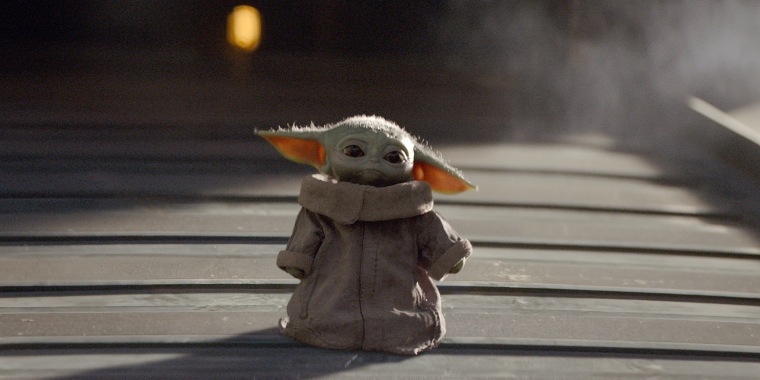We can all agree that Baby Yoda is absolutely, tear-jerkingly adorable, right? But what you probably didn’t realize is that Baby Yoda is indigenous — or, in the outdated way of saying it, Native American. But to which tribe or nation does he belong? We’ll get to that.
Want more articles like this? Sign up for the THINK newsletter to get updates on the week's most important cultural analysis
Since Disney Plus introduced us to “The Baby Yoda Show” — excuse me, I mean, “The Mandalorian” — the big-eared, round-eyed, green ball of cuteness has inspired artwork, witty memes and GIFs the world over. Memes, GIFS and emojis are, of course, today’s hieroglyphics; They are how the internet generation has come to communicate with one another, especially when, really, there are no words. Sometimes a GIF of a shrugging Dr. House or a befuddled President Barack Obama perfectly communicates what words cannot — and any meme or GIF of Baby Yoda is clearly the highest form of said communication.
But in Indian country, Baby Yoda has struck a particular chord: His Adorableness has been the inspiration behind paintings, beaded patches, medallions, earrings and T-shirts made by indigenous folks in the U.S. and Canada, all in homage to the little guy.
So why, then, do Natives relate to Baby Yoda so deeply?
First, there’s a thing we do as Natives which has come to be known as “indigenization” which is when, inspired by art or pop culture, we give it an indigenous spin — something our communities can relate to, and that’s what we’ve done with Baby Yoda.
Indigenization is about representation: There isn’t a lot of media made for the indigenous community, let alone positive media made respectfully about indigenous people, unless we make it ourselves. There’s not a single mainstream TV sitcom about a Native family; there’s never been a cast member of Saturday Night Live who was Native. Whether on Netflix, HBO or Hulu, there’s just not a lot of Native content — so we make it ourselves, or give something indigenous flavor, as we have with Baby Yoda.
And we see a little — or even a lot — of our people in Baby Yoda. “When I see Baby Yoda, I see an indigenous baby at ceremony learning the wisdom of our ancestors, wisdom that has been passed down for thousands of years,” Tara Houska, an Ojibwe and diehard “Star Wars” fan, said.
Baby Yoda is each of us, when we were kids growing up at pow wows, protests, rallies, and marches, or he is today’s Native baby, learning the ways of the force, fumbling and eager, yet “not ready.” And, one day, babies are no longer babies, but learned adults, prepared to fight, to lead, to teach and to pass on the wisdom to the next generation.
In the meantime, while they’re still incredibly adorable bundles of indigenous goodness, like Baby Yoda — our tiny tots, which, at age five and under, is the absolute cutest, irresistible dance category at pow wows.
As soon as the pow wow emcee calls the category over the mic, babies in feathers and bustles and beads wobble to the center of the arena, then bounce to the beat of the drum, no footing at all, jelly for legs. Meanwhile, grandma, mom and aunty snap photos from the rim, and everyone waiting for fry bread are torn between losing their place in line or missing out one of the best parts of any pow wow anywhere.
In this case, move over Baby Yoda. Tiny tots have you beat every time.
And even if you’ve never been to a pow wow, just picture a cute kid doing cute kid things, and then just imagine that cute kid is Baby Yoda.
But the real question for Native people isn’t whether Baby Yoda is one of us — he is — but to which nation or tribe he belongs. The Ho-Chunk will tell you he’s Ho-Chunk. The Ojibwe will tell you he’s Ojibwe. I’m Oglala, so of course Baby Yoda is Oglala. Each indigenous fan can — and will — present their argument for why he’s more Diné (Navajo) or Tulalip or Choctaw or Cherokee and so on.
Regardless of what tribe or nation Baby Yoda is — again, he’s obviously Oglala, I can’t state this more clearly — he is incontrovertibly Native. Don’t even bother trying to argue this point.
And until Natives are included in the modern American narrative in pop culture — beyond, lest we forget, the fact that Carrie Fisher’s famed two-bunned hairstyle in “Star Wars: Episode IV - A New Hope” was inspired by the Hopi and their “squash blossom” loops — outside of racist mascots and that tired, banal cowboys and Indians motif, we will continue to claim our icons where we find them and produce our own content.
So the next time that you watch “The Mandalorian,” just remember, the show is a Western and that kidnapped baby is indigenous. We know the narrative; we’ve seen it before. Plus those green ears are really just two big, beautiful Native braids. Once you see it, you can’t un-see it. (And if you can’t, well, just use The Force.)
Related:
